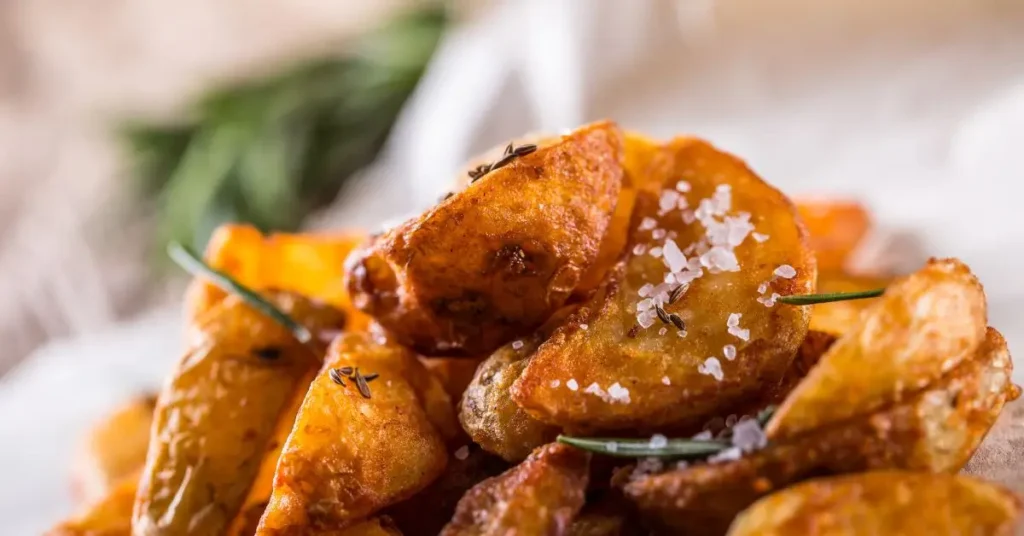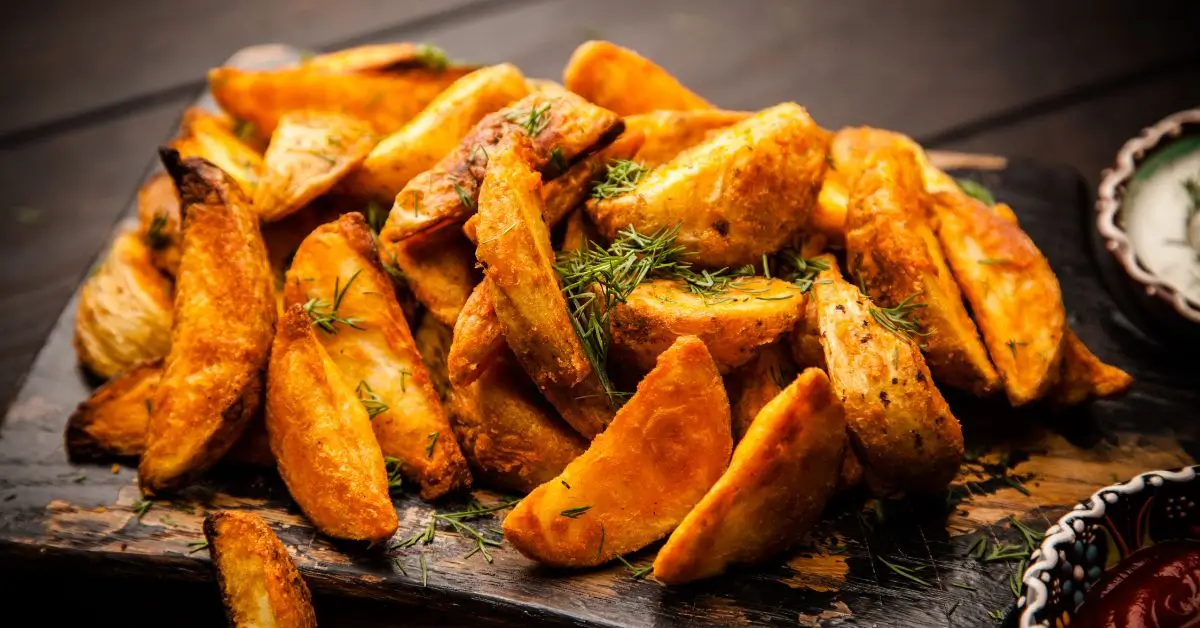Crispy roast potatoes, a staple in culinary traditions worldwide, have garnered immense popularity for their irresistible combination of a golden, crunchy exterior and a soft, fluffy interior. Revered for their versatility, these delectable morsels effortlessly transition from a comforting Sunday dinner side to a cherished feature in festive feasts. Their universal appeal lies in the simple yet sublime experience they offer – a harmonious blend of textures and flavors that tantalize the taste buds.
In this comprehensive guide, we aim to unveil the secrets to achieving the perfect crispy roast potatoes. Whether you’re a seasoned cook or a kitchen novice, our step-by-step approach, infused with expert tips and tricks, will empower you to master the art of making these beloved crispy delights. From selecting the right potato variety to mastering the roasting technique, we’ve got you covered. Let’s embark on this culinary journey to elevate your roast potato game to new heights of deliciousness!
The Basics of Crispy Roast Potatoes
Choosing the Right Potato Variety
The journey to crispy roast potatoes begins with selecting the appropriate potato variety. Not all potatoes are created equal when it comes to roasting. Starchy potatoes like Russets or King Edwards are ideal, as their high starch content breaks down into a fluffy texture when cooked, providing the perfect canvas for a crispy exterior. Waxy potatoes, on the other hand, tend to hold their shape and are less suitable for achieving that coveted crunch.
The Science Behind Crispy Exteriors and Fluffy Interiors
The secret to the perfect roast potato lies in the science of cooking. When potatoes are heated, the starch granules absorb moisture and swell, eventually bursting and releasing starch molecules. These molecules then form a network that traps air and moisture, creating a fluffy interior. For the exterior, the Maillard reaction plays a crucial role. This chemical reaction between amino acids and reducing sugars gives the potatoes their golden-brown color and crispy texture. Achieving this balance between a crispy outside and a fluffy inside is the hallmark of a well-roasted potato.
Essential Ingredients and Tools
- Ingredients: Apart from the potatoes, key ingredients include oil or fat (like olive oil, duck fat, or butter) for roasting, and seasonings such as salt, pepper, and herbs for flavor.
- Tools: A sharp knife for cutting, a large pot for parboiling, a colander for draining, and a roasting tray are essential. Additionally, a potato peeler, kitchen towels for drying, and a spatula for turning the potatoes during roasting can be very helpful.
By understanding these basics and preparing with the right ingredients and tools, you’re well on your way to creating delicious, crispy roast potatoes that are sure to impress.
Preparing Your Potatoes
Washing and Peeling: Best Practices
The first step in your crispy roast potato journey is to properly wash and peel your potatoes. Washing is crucial to remove any dirt or debris. Use cold water and gently scrub the skin with a brush. Peeling is optional and largely depends on personal preference. While some enjoy the rustic feel and additional nutrients the skin provides, others prefer the uniform texture and appearance of peeled potatoes. If you choose to peel, do so thinly to preserve as much of the potato as possible.
Cutting Techniques for Optimal Crispiness
Cutting your potatoes correctly is key to achieving maximum crispiness. Aim for even-sized chunks – not too small, as they might disintegrate, and not too large, as they may not cook through evenly. A size comparable to a golf ball is a good standard. For extra surface area, which translates to more crispiness, consider cutting your potatoes into halves or quarters, depending on their size. The more edges and corners, the better, as these areas crisp up beautifully in the oven.
To Soak or Not to Soak: Debating the Starch Removal Step
Soaking potatoes in cold water before cooking is a debated topic. This step is said to remove excess starch, which can lead to crispier results. However, it’s not always necessary, especially if you’re using a high-starch potato variety. If you decide to soak, leave the potatoes in cold water for at least 30 minutes and then thoroughly dry them before cooking. Remember, moisture is the enemy of crispiness, so drying your potatoes well is crucial, whether you soak them or not.
By following these preparation steps, you’re setting the stage for perfectly crispy roast potatoes. Each step, from washing to cutting, plays a significant role in the final texture and taste of your dish.
The Secret to Crispiness: Parboiling
The Role of Parboiling in Achieving Crispiness
Parboiling is a critical step in the quest for crispy roast potatoes. This process partially cooks the potatoes and starts the breakdown of their starches, which is essential for achieving that coveted fluffy interior and crispy exterior. Parboiling creates a rough surface on the potatoes, which, when roasted, leads to more edges and a greater area becoming deliciously golden and crisp.
How to Correctly Parboil Potatoes: Timing and Techniques
- Water Temperature: Start with cold water. This ensures that the potatoes cook evenly, inside and out.
- Salt: Add a generous amount of salt to the water. This not only seasons the potatoes but also helps break down their surfaces, enhancing crispiness.
- Timing: The duration of parboiling is crucial. Typically, 7-10 minutes from the time the water starts boiling is sufficient. The potatoes should be softened at the edges but still firm in the center.
- Post-Parboiling: After draining, let the potatoes steam dry for a few minutes or gently shake them in the colander. This helps to roughen their surfaces, creating more crevices for a crispier outcome.
The Baking Soda Trick: Understanding Its Impact
Adding baking soda to the parboiling water is a little trick with a big impact. Baking soda, being alkaline, breaks down the potato surfaces, making them more amenable to crisping up. A small amount, about a half teaspoon for a pot of water, is enough. This trick enhances the Maillard reaction, leading to a more pronounced golden-brown color and a crisper texture.
By mastering the art of parboiling, you’re not just cooking potatoes; you’re setting the stage for a transformation that results in the ultimate crispy roast potatoes. This step, though simple, is the game-changer in your roasting process.
Seasoning and Flavoring
Classic and Innovative Seasoning Ideas
Seasoning is where you can get creative and tailor your crispy roast potatoes to your taste preferences.
- Classic Seasonings: Salt and black pepper are the traditional go-tos. They enhance the natural flavor of the potatoes without overpowering them.
- Innovative Twists: For a modern take, consider garlic powder, onion powder, smoked paprika, or even a sprinkle of Parmesan cheese. These add depth and a unique flavor profile to your dish.
The Role of Fats: Choosing Between Oil, Butter, and Animal Fats
The type of fat used not only contributes to flavor but also affects the texture of your roast potatoes.
- Olive Oil: A healthy option that gives a crispy texture and a subtle, fruity undertone.
- Butter: Adds a rich, creamy flavor but can burn easily; best used in combination with oil.
- Animal Fats (like Duck Fat): These fats are traditional choices that impart a distinct, luxurious taste and achieve an unbeatable crispiness.
Herbs and Spices that Complement Roast Potatoes
Herbs and spices can elevate your roast potatoes from simple to spectacular.
- Rosemary and Thyme: These robust herbs withstand the high roasting temperatures and infuse the potatoes with a woodsy aroma.
- Chives or Parsley: Added after roasting, they bring a fresh, vibrant note.
- Spices: Cumin, coriander, and turmeric can introduce an exotic twist, while a hint of cinnamon or nutmeg adds a surprising yet delightful touch.
Experimenting with different combinations of seasonings, fats, herbs, and spices can transform your crispy roast potatoes into a dish that not only tantalizes the taste buds but also perfectly complements the rest of your meal.
Roasting Techniques
Oven Temperatures and Positions for Even Roasting
- Temperature: A high oven temperature is key. Roasting at around 425°F (220°C) is ideal. This high heat ensures a crispy exterior while keeping the inside fluffy.
- Positioning: Place your roasting tray in the upper third of the oven. This spot typically has consistent heat and helps in achieving an even golden crust on the potatoes.
The Debate: To Cover or Not to Cover
- Uncovered Roasting: Traditionally, roast potatoes are cooked uncovered. This method allows the heat to directly crisp up the potato surfaces.
- Covered Roasting: Some argue that covering the potatoes for part of the cooking time can speed up the process and ensure they’re cooked through. However, remember to uncover them for the last part of roasting to achieve crispiness.
Turning and Basting: Ensuring All-Around Crispiness
- Turning: Halfway through the roasting process, turn the potatoes. This ensures that each side gets evenly crisped and browned.
- Basting: If you’re using fats like duck fat or butter, basting the potatoes midway through can enhance their flavor and aid in even crisping. Be gentle to avoid breaking the potatoes apart.
By mastering these roasting techniques, you can ensure your potatoes are perfectly crispy on the outside and deliciously fluffy on the inside. Remember, patience is key – good roasting can’t be rushed!
Advanced Tips and Tricks
Utilizing Semolina or Cornflour for Extra Crunch
- Semolina: Dusting your parboiled potatoes with semolina before roasting can add an extra layer of crunch. The coarse texture of semolina creates a more rugged surface that crisps up beautifully in the oven.
- Cornflour: Similarly, cornflour (or cornstarch) can be used for a lighter, yet equally crispy coating. It forms a thin crust on the potato surface, enhancing the crispiness without overpowering the potato’s natural flavor.
The Impact of Preheating Your Roasting Tray
- Preheating the Tray: Placing your roasting tray in the oven as it preheats can make a significant difference. When you add the potatoes to a hot tray, they start crisping immediately, sealing the exterior for a better crunch.
- Oil or Fat on the Tray: Adding oil or fat to the tray before it goes into the oven ensures it’s hot and ready to create a crispy layer as soon as the potatoes hit the pan.
Experimenting with Different Cooking Methods: Air Frying and Grilling
- Air Frying: For a healthier alternative, air frying can yield impressively crispy potatoes with minimal oil. The rapid air circulation in an air fryer mimics the effect of deep-frying, crisping up the potatoes evenly.
- Grilling: Grilling roast potatoes adds a smoky flavor that can’t be replicated in an oven. For grilling, it’s best to partially cook the potatoes beforehand, either by boiling or microwaving, to ensure they’re cooked through and crispy on the outside.
These advanced techniques can elevate your crispy roast potatoes, adding unique textures and flavors. Don’t be afraid to experiment and find the method that works best for you.
Common Mistakes to Avoid
Overcrowding the Pan: Why Space Matters
- Space for Crispiness: Overcrowding your roasting pan can lead to steaming rather than roasting. Each potato piece needs enough room for the heat to circulate around it, ensuring even cooking and crispiness.
- Batch Cooking: If necessary, cook in batches rather than compromising on space. This might take longer, but the results – perfectly crispy potatoes – are worth it.
Under or Over-Seasoning: Finding the Balance
- Seasoning Proportion: It’s easy to under-season and end up with bland potatoes or over-season and make them unpalatably salty. The key is to season in stages: during parboiling, before roasting, and a final adjustment after cooking.
- Taste Test: If possible, do a taste test after parboiling to gauge the level of seasoning, adjusting accordingly before the final roast.
Timing Issues: Avoiding Under or Overcooking
- Undercooking: Undercooked roast potatoes can be hard and unappealing. Ensure they are fork-tender before removing them from the oven.
- Overcooking: Overcooked potatoes may become dry and lose their fluffy interior. Keep an eye on them, especially towards the end of cooking time, and use visual cues – a golden-brown crust – as a guide.
By avoiding these common pitfalls, you can significantly enhance the quality of your crispy roast potatoes, turning a good dish into a great one.
Pairing and Serving Suggestions
Best Dishes to Serve with Crispy Roast Potatoes
- Roast Meats: Crispy roast potatoes are a classic accompaniment to roast meats like beef, lamb, or chicken. Their crunchiness complements the tender, juicy meat perfectly.
- Vegetarian Options: Pair them with a hearty vegetarian main, like a nut roast or grilled portobello mushrooms, for a satisfying meal.
- Fish: Serve alongside baked or grilled fish for a lighter, yet fulfilling dish.
- Breakfast or Brunch: Incorporate crispy roast potatoes into a breakfast hash or serve them with eggs and bacon for a hearty brunch.
Creative Serving Ideas: From Casual to Gourmet
- Casual Gatherings: For a more relaxed setting, serve the potatoes as a part of a buffet or family-style meal. You can also offer them as a snack with dips like aioli or ketchup.
- Gourmet Twist: Elevate the dish for a more formal occasion by adding gourmet ingredients like truffle oil, freshly grated Parmesan, or a sprinkle of fresh herbs like rosemary or thyme.
- International Flavors: Spice them up with seasonings from around the world – think za’atar for a Middle Eastern touch, or a sprinkle of furikake for a Japanese-inspired flavor.
- Presentation: Serve in a rustic, elegant dish to enhance the visual appeal, garnishing with fresh herbs or a light drizzle of a complementary sauce.
With these pairing and serving suggestions, crispy roast potatoes can be a versatile side that enhances a wide range of meals, from the everyday to the special occasion.
FAQs Section
How Can I Make My Roast Potatoes Extra Crispy?
- Parboil and Roughen: Parboil your potatoes and then shake them in a colander to roughen their surfaces. This creates more edges that crisp up in the oven.
- Use the Right Fat: Cooking fats like duck fat or a high smoke point oil can make your potatoes crispier.
- High Heat: Roast your potatoes at a high temperature (around 425°F or 220°C) to ensure a crispy exterior.
- Baking Soda: A pinch of baking soda in the boiling water can break down the potato surfaces, making them crispier when roasted.
Can I Make Crispy Roast Potatoes Ahead of Time?
- Partial Cooking: You can parboil and season the potatoes ahead of time. However, for the best texture, roast them just before serving.
- Reheating: If you must roast them in advance, reheat them in a hot oven for 10-15 minutes to bring back some of the crispiness.
Are Crispy Roast Potatoes Healthy?
- Moderation is Key: While potatoes are a good source of vitamins and fiber, the oil or fat used in roasting can add calories. Using healthier oils and controlling portion sizes can make them a healthier choice.
- Baking Instead of Frying: Roasting is a healthier cooking method compared to deep-frying, as it uses less oil.
Can I Use Sweet Potatoes Instead of Regular Potatoes?
- Absolutely: Sweet potatoes can be a delicious alternative. They have a different flavor profile and texture but can still be made crispy following similar methods.
What Are the Best Herbs to Use for Roast Potatoes?
- Robust Herbs: Rosemary and thyme are classic choices that withstand high roasting temperatures.
- After Roasting: Delicate herbs like parsley or chives can be sprinkled on after cooking for a fresh flavor.
- Experiment: Feel free to experiment with other herbs like oregano, sage, or dill to find your preferred flavor combination.

Crispy Roast Potatoes
Ingredients
Instructions
Notes
Conclusion
In our journey to perfect the art of making crispy roast potatoes, we’ve explored various essential aspects, from selecting the right potato variety to mastering the roasting techniques. We’ve learned that the key to achieving that desirable crispy exterior and fluffy interior lies in the details: the parboiling process, the choice of fat, and the seasoning techniques. We’ve also delved into advanced tips like using semolina or cornflour for extra crunch and the importance of not overcrowding the pan.
Remember, cooking is as much about personal preference as it is about technique. Don’t hesitate to experiment with different seasonings, cooking methods, and potato varieties. Each variation brings its unique flavor and texture, allowing you to discover the roast potato style that best suits your taste.
Whether you’re preparing a cozy family dinner or a special feast, crispy roast potatoes are a classic dish that never fails to impress. So, go ahead, use this guide as your starting point, and embark on a culinary adventure to create your version of the perfect crispy roast potatoes. Happy cooking!

